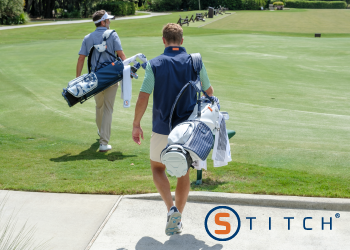ProSendr Training Aid Review
Nothing else brings hope to the struggling golfer like watching a well-produced training aid advertisement. It’s intoxicating and we’re all susceptible to them. A little over six months ago, videos of the ProSendr, a training aid designed by Sean Foley and David Woods, began to surface on social media. Their initial marketing campaign was masterfully done and drove consumer interest to a level that isn’t all that common in this market segment. However, marketing doesn’t always equal improvement, so we were glad to get the ProSendr in hand to try it out for ourselves.

What is ProSendr?
ProSendr provides a detailed description of the device, along with a list of exactly how it promotes a better swing on their website. It’s worth checking out, though a word of warning: the language may be unfamiliar to those that don’t consider themselves “swing nerds”. We’ll do our best to simplify it.

In each ProSendr box is the carbon-fiber wrist cradle with a Velcro cuff, the compression sphere, and a carrying bag. The wrist cradle almost resembles something one with a wrist injury would wear, though you’ll notice in the picture above that, rather than keeping the wrist straight, it’s designed for the wrist to be bent back. This is really what the ProSendr is all about, and it’s worth running through exactly why it’s designed this way.
First though, we need to discuss what the right wrist does in the golf swing. There are quite a few misconceptions here, and some people may play their entire lives without really understanding how the wrists work. Many players focus on “cocking” their wrists, which is called radial deviation. Some people describe it as the feeling of making a fist. An easy way to feel this is to stand at address and lift the club up using only the wrists. While there is an element of wrist cocking in the golf swing, a little goes a long way. The picture below illustrates “cocking”, or radial deviation.

While there is an element of radial deviation in the golf swing, the movement of the wrist that many aren’t aware of (and is considered most important for things like shallowing the club and encouraging shaft lean at impact) is called extension. The easiest way to feel this is to hold your hand straight out and pull your knuckles back towards your forearm. The picture below shows right wrist extension with a golf club in hand.

It’s also important to remember that when the right wrist is in extension the left wrist is doing the opposite. For those folks wanting a flat left wrist at the top of their backswing, the right wrist must be in extension. Many slicers of the ball will find they do the exact opposite of this, both in the takeaway and top of their backswing, and it can lead to a number of clubface and swing path issues. The picture below shows the two wrists working together, the left wrist flat (in flexion) and the right wrist in extension.

If you’re still with me, congratulations! I know the mechanics of the wrist can be a bit of a bore. The question now is how does this relate to ProSendr? The answer is simple. ProSendr’s stiff, carbon-fiber cradle is angled in a way that gives tactile feedback when your right wrist is in extension. In addition, it limits radial deviation (cocking) so that you don’t overdo it, causing those huge, ungainly backswings where the club disconnects from the body.
After fastening ProSendr to the forearm with the Velcro cuff, it’s instantly clear what it wants you to do. By extending the right wrist a bit, the top of the right hand comfortably rests against the cradle. That’s it – right wrist extension in a half second.
ProSendr Protocols and Practice
Now that you’ve got ProSendr attached to your wrist, what’s next? Unlike many training aids that force you into a position and allow you to just start swinging, ProSendr gives you tactile feedback when you’re in the right positions, so it’s probably most efficient with some sort of help getting there first. Luckily, the company offers a set of five protocol videos that take you from the takeaway through impact. They provide useful information and routines to utilize the device the way they’ve designed it. For an extra fee, there are bonus videos that expand on the general concepts.

This does bring up a small weakness of the device – the free protocol videos aren’t that long, and they aren’t that detailed. Yes, they offer useful guidelines and tips, but they did leave us wishing they were more comprehensive. A good example of how this caused some issues in real-world use popped up during our testing. The simple act of putting on ProSendr correctly isn’t exactly that simple. The video spent about 10 seconds talking about this, but we found that aligning it improperly, even a very slight amount, caused several issues. It’s difficult to explain, but to keep it short: If the device is rotated to the left or right too much, it can encourage too little or too much wrist cocking, which can produce some unwanted effects in the golf swing. Some suggestions for improvement would be a more detailed instructional guide or even a user community where people could seek feedback.
Once we sorted out the correct way to wear the device, there is no doubt that it provided consistent and repeatable encouragement to maintain the proper wrist conditions up to the top of the backswing. We found it more difficult to keep these positions in the downswing due to some chronic casting issues, but slow repetitions and a determined focus on feeling the top of the hand in the cradle did result in a noticeably improved shaft angle at impact. This illustrates ProSendr’s philosophy that they want players to take ownership of their swing. While the device will not do the work for you, it will give you the ability to self-monitor throughout the entirety of the golf swing.
We felt ProSendr would be especially helpful for those players that struggle with rolling the face open at takeaway. Conversely, it sometimes exacerbated a closed face at takeaway, especially before we figured out how to wear it properly, so it is worth keeping an eye on that if you already have issues shutting down the face. Also, it’s important to note that this is a one-size-fits-all device, so those players with very small or very large hands may struggle to get a perfect fit.
Compression Sphere
In addition to the cradle, ProSendr comes with a blue compression sphere. This rubbery skeleton of a sphere has Velcro at one end that attaches to the wrist cuff. The compression sphere can be used with the cradle attached or the cradle can be removed.
The concept of the compression sphere isn’t new. For many years, instructors have told students to hold a ball between their forearms to improve things like connection and width. There are even quite a few similar training aids on the market that can be purchased. ProSendr’s compression sphere is a little different than something like Tour Striker. First, it’s much smaller (about the size of a softball), but it’s also designed to be placed closer to the wrists (as opposed to closer to the elbows). Also, the compression sphere stays firmly in place, no matter how successful you are in using it. A plain ball or Tour Striker will typically fall to the ground if the user loses a firm body/arm connection.
While we liked the concept of ProSendr’s compression sphere, there was more of a learning curve than we expected, and it was somewhat uncomfortable to use. Because it sits so close to the hands, the amount of space it can fill is very small. While it’s bendable (meaning it’s designed to be crushed down a bit), it requires a great deal of arm tension to hold the club properly while it is in position, which resulted in some very stiff swings. In addition, it must be stuck to the cuff at a very exact spot (that is only found via guesswork), or you’ll find yourself contorting your forearms in unnatural positions.
It was easiest to use the compression sphere without the cradle attached to the cuff, but we never found great comfort with it. While it is a nice idea, it almost seems like an afterthought that needs a little more engineering. At the least, a more thorough instructional guide for getting it put in the right place would be useful.
Details
One truth remains and always will remain: There is no magic device that will cure your golf swing. Even ProSendr, which we were very impressed with, requires knowledge, deliberate and informed practice, and time to show results. It does an exceptional job at what it’s designed to do though. Yes, we pointed out some things that could improve the device, but its core functionality is solid and could be useful for many players that struggle with knowing exactly how their wrists should be working in the golf swing.
- $169.00
- Made for RH/LH
- Available at prosendrgolf.com















[QUOTE=”Fatboyslim, post: 11893408, member: 76976″]
Yea I give him too much credit. Tiger’s Pro. My guess is you still have your pet rock.
[/QUOTE]
You think I do not know that he was Tiger’s Pro? People use their fame to sell all sorts of things, it is ingrained in America’s culture of consumerism to maximize your earning potential by pimping just about anything. He is not inventing something, the R&D is minimal to none for a product like this (especially with its flaws). That is why the eBay seller can 3D print it and the THP DIYer can assemble one from off the shelf products (shin gaurd).
I’m not looking for an argument. Most are in agreement that [I]the product is useful,[/I] overpriced, and has serious flaws. Some will overlook the price and roll the dice with the flaws, others will look elsewhere to solve their problems.
BTW – You should listen to him on the NLU podcast. He has interesting thoughts on how he would coach now vs long ago in his career. He is all about neuroscience, now that he has been exposed to it and his philosphy now seems more along the lines of Pia Nilsson.
Had a lesson today for first time in a month (have been going every 2-3 weeks) after spending a couple weeks using the prosendr for 5-10 reps a day.
Instructor said I really like where you are in your backswing, now lets work on a couple other things… that is huge because most of my issues are from backswing issues. Going to keep up with the prosendr to try and fully ingrain that backswing then spend more time on the new stuff from today.
[QUOTE=”PiratePenguin, post: 11892070, member: 2635″]
First session today with the Pro Sendr. I had already watched all of their official protocol videos on YouTube and some other teachers discussing it over the weekend while my left knee recovered from an injection on Friday. Since it finally felt good enough to maybe swing on I decided to go easy and just do some PS work. Started with the protocol videos in order, doing the 15 reps of each, following along, trying to really get a feel for what they were discussing. After that I hit a few balls at 3/4 speed using foam practice balls into the screen, no monitor or anything, no looking for ball feedback, just to feel the swing differences.
Pros: It definitely puts me into a different position at the top of the backswing – not as far back or around, left wrist much more flat/a little bowed, right hand more back instead of pulled thumb side.
Cons: I may be too small for its “one size fits most” sizing. I’m 5’9″, 145 lbs, small polo, cadet medium glove… absolutely on the smaller side of average for an American male. My right hand in no way fills that cradle. On the backswing drill I barely make contact with it if I have the sleeve pushed all the way down to the end of my wrist, and my trigger finger can fit into the slot at the top of the backswing but is contacting the bottom portion of that finger nook only.
I’m going to keep using it for a few weeks and see how it goes, but after day one I’m not sure it fits me well enough to get full use out of it. I have to really compress the hell out of the ball if I try to use both since the cuff has to sit so far down my right wrist. If I take off the cradle and move the cuff further up my wrist the compression ball works better. I’ll keep trying the protocols as warm ups, and do some chipping with it as Mark Crossfield outlined in his video.
Love the concept, but they need a smaller version for smaller men, juniors, women, etc. Maybe they will if it is successful enough.
[/QUOTE]
Gave it another shot. Not gonna work. Too big / my wrist and hand too small. Back to eBay it goes. Which sucks because I can tell it would help me. :mad:(n)?
Be cool if this thing had a built in hackmotion style of sensor
[QUOTE=”McLovin, post: 11897315, member: 23812″]
messed around with this at my lesson today. it helped me shallow out my pitching motion. it feels so awkward but i got somewhat used to it.
[/QUOTE]
The more I have used it the more natural it has become. I was shocked when my instructor actually said something about my backswing…. that doesn’t happen much. Not sure it was worth the $200 I paid, but hard to put a value on that.
Went down a youtube rabbit hole with Pete Cowen as the star of the show. His fundamental downswing (and back swing really) focus lines up about perfect with the prosendr… I think.
I have gotten lax and not getting the reps in with ProSendr, need to get back to it.
[MEDIA=tiktok]7325958108071644458[/MEDIA]
Looks like the Finau family are fans of it too. Not sure if they are getting paid for it or not.
I did not think their videos were very good and bad angles. I did not think it is easy to monitor yourself on how to use and I thought it was uncomfortable. I would need to work with an instructor to help me groove the ideals into my swing so right now it’s collecting dust.
I appreciate your review and agreed with you.